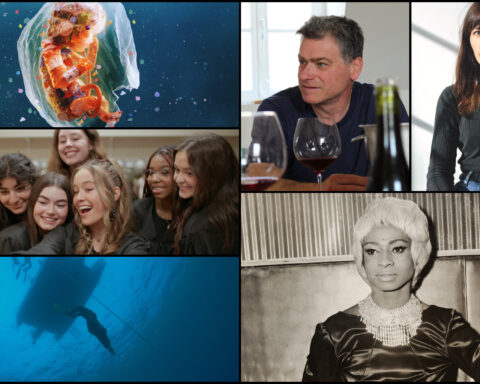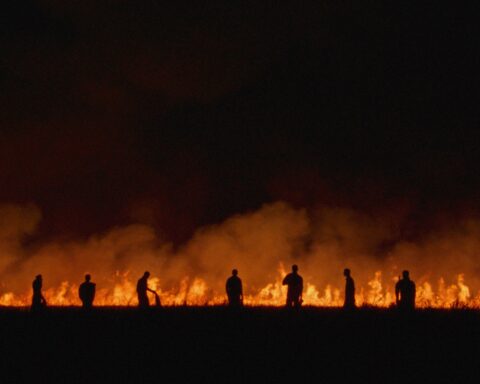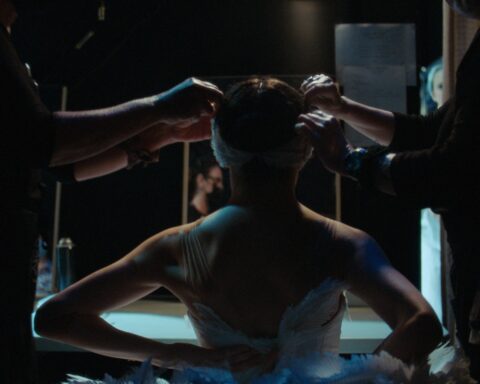42 thousand feet above the earth. I am watching a movie. I am, in fact, in the heavens, in a metal can, watching a movie—a documentary, in fact.
You think the Voice of God is a dated relic? Not here in the heavens. Lorne Greene’s (1) baritone has modulated into postmodern porridge, its atomic weight the same. Why it has the identical authority! But now it’s fortified with the slippery sheen of an untouchable globalized economic dictate and hiding under the surface of a doc that isn’t even ‘narrated’.
I was on my way from Vancouver, flying in for a candidate interview. The job (2) was with a university in Toronto to teach ‘film’. I was watching Manufactured Landscapes, a prominent documentary. Exactly this time last year, POV featured the film, with a complimentary cover story. Many of you have seen the movie. It is coolly representative of a pervasive yet unacknowledged nihilism. It is a pretty work, not actually new in form or content (what year was Koyaanisqatsi?), masquerading as concerned political commentary.
This heralded film uses a camouflaged formalism, one that neglects analysis and opinion. Rather, it aestheticizes frigidly, floating above the turbulence of the troposphere: it contains little individual reflectivity, no individual idiosyncrasies. It portrays people, the 1.3 billion population of China, as one would imagine the most retrograde Politburo member or any red neck would, as a toiling mass. It is nearly as blandly precise, controlled and mechanical as its subject matter, the photographer Edward Burtynsky. (3)
As we drown in garbage, swelter in heat, and see our political culture at most as a mortgaged future, we are being entertained and edified by the triumphant artistry of our own demise.
Manufactured Landscapes features an unforgivable incident. Burtynsky orders trash picking children to assume particular poses, higher up on the garbage pile, creating a mise-en-scene for his camera, resulting in an expensive purchasable print for an art gallery. The film does, by contrast, include an engaging and thoughtful moment, presumably shot by Peter Mettler: the camera looks on as an elderly Chinese matron works on her sewing.
“Confessions of guilt are the best possible safe- guards against collective action…and the very magnitude of the crimes, the very best possible excuse for doing nothing.” — Debord or was it Virilio?(4)
As I write this, I can see a huge billboard outside my apartment stating “Beauty That Knows No Bounds — Buick Enclave.” If you want to know how you should think — according to the accepted zeitgeist of the master narratives — decipher current high-end advertising slogans. They will tell you straight out what many of the galleries are husking as subtle tonations (in fact, repackaged clichés) at a high art price.
The aesthetic of the suffering of others and even of oneself, the perversity of screen distance and the lovely framing of trash and industrialism, creates a beauty that knows no bounds.5 It is not compassion, nor intellectual engagement, but sadism and masochism that draw the audience to these new ‘works’. As the spiral of blunder, desecration, and crisis is tightened for the subject, the audience unconsciously sips the putrid breath of death and destruction and exclaims in her heart: life.
The pre-eminence of the image in capitalist society is less a commoditization than a marker. The exchange is: my time for your presentation. The marker of time, the image, is the production of observation. Observation is the twinning of the phenomenological and the informed. Information however does not create the informed. Only a set of ideas can do that and only organizing with others will make it real.
So I got on a taxi from the airport to my hotel. The driver was a chatty recent immigrant from China. We got around to talking about visiting China. I said something stupid like “there’s too many people there” or “I don’t like crowds.” And he said to me, cutting but friendly, “hey, you’re only going to meet one or maybe two people at a time; what’s your problem!?” I laughed and I thought ‘brilliant’, and when I got to the interview, I managed to sneak in my critique of this prominent Canadian documentary and the story of the wisecracking cab driver.
I took the morning flight back to the coast; didn’t watch any movies, opting for a book. Months later I found out that I didn’t get the job. In fact, no one did. The Faculty and the Dean couldn’t agree as to who was the best person for the job.
Footnotes
1. Lorne Greene (February 12,1915–September 11, 1987) was a Canadian actor who made it big in the US. He had an incredibly commanding voice that was used in numerous early NFB documentaries. The CBC called him “The Voice of Canada”; however, his role in delivering distressing war news in sonorous tones following Canada’s entry into World War II in 1939 caused many CDN listeners to nickname him “The Voice of Doom.”
2. Please read eventually the works of Andrew Ross. An enlightening interview between him and Geert Lovink dealing with the current situation of the creative economy, China, labour organizing in the era of the knowledge industry, etc. can be found online. “The effort to industrialize custom creativity is a primary goal of capitalist produc- tion right now.”–A.R.
3. Apparently there is a brisk market for images of industrial waste, witness the work of J. Henry Fair, a photographer in NYC who also specializes in such scenes. His portfolio was given attention in the August 2007 edition of Harpers.
4. Marc Glassman points out to me that this is a misquote from Hannah Arendt who wrote: “Where all are guilty, no one is; confessions of collective guilt are the best possible safeguard against the discovery of culprits, and the very magnitude of the crime the best excuse for doing nothing.”
5. In the previous article about ML, the producer de Pencier praises Burtynsky’s “What is unique about Ed’s photographs is that they hang in the boardrooms of corporations and those of Greenpeace.” Not realizing that the essential insignificance of the pieces make them a perfect match for any institutional décor, a noise that signifies nothing and everything. They are the best possible safeguard against the discovery of the culprits….











